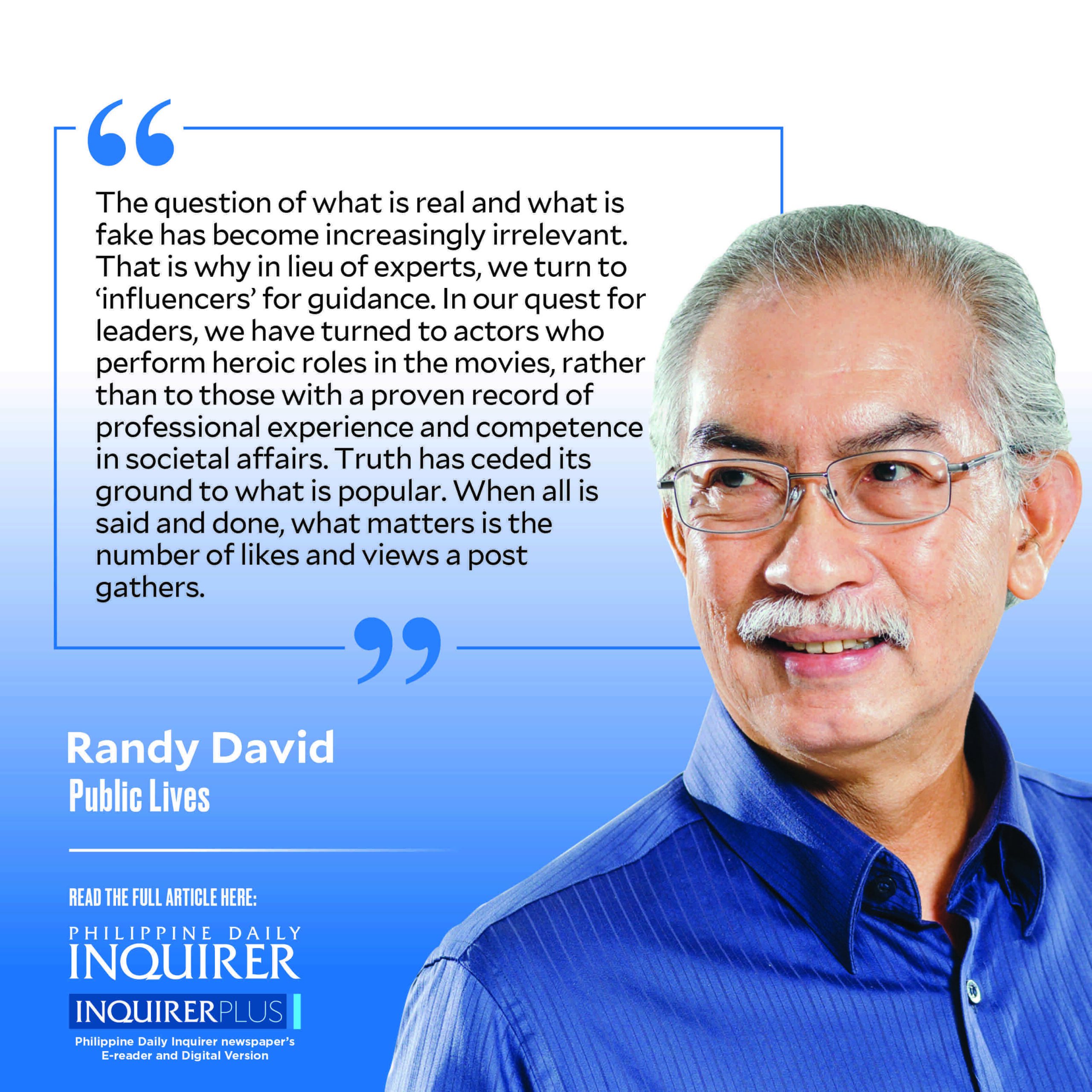
Early this week, a fake video of President Marcos went viral on a popular streaming platform. It showed the president purportedly directing the country’s armed forces to counter China’s aggressive moves in the South China Sea. The short video was taken down just a few days after. Not having personally seen it, I can’t say how real it looked.
So-called deepfakes are actually not so difficult to spot, at least for now—provided one is prepared to take time to scrutinize key features of people’s faces, like the forehead, the lips, the eyes, the eyebrows, cheeks, ears, the nose, etc. Often, the edges of the face may be blurred. Shadows may not be there, as one might expect in a given angle of light. Eyeglasses may not show any glare or reflect too much glare. The lips may not move in synchronicity with the sound.
But, with their increasing technical sophistication, artificial intelligence (AI)-generated images may soon be almost impossible to detect if we merely rely on an examination of facial features and voices. Deepfakes can be as good as the ones we encounter in the real world.
This is where it becomes crucial for people to develop a self-conscious awareness of how they perceive and give meaning to the images, signs, and events occurring around them. In everyday life, understanding is something that occurs almost automatically. We don’t have to see everything before we could grasp what is happening. Our minds tend to fill the gaps—and so we read more than what is actually there.
It is a mental shortcut that saves precious time, but which magicians and illusionists deftly exploit in order to create an illusion. AI-generated texts and images ride upon this perceptual habit to be able to pass off their products as though they were of real human beings, and not images constructed by machines.The blurring of the lines between appearance and reality, particularly in the age of mass media, struck the 19th century Danish philosopher and theologian Søren Kierkegaard with such alarming clarity that he wrote, against the backdrop of Europe’s revolutions: “A revolutionary age is an age of action; ours is the age of advertisement and publicity. Nothing ever happens but there is immediate publicity everywhere.”
This seems to me to be an apt description of our own age. Let us consider a few random examples from our news cycle. Pastor Apollo Quiboloy has been the object of a police manhunt for over a month now. The House of Representatives, the Senate, and the Department of Justice have all been looking for him, and everyone says he has not left his community in Davao. Yet, despite all the publicity, he is nowhere to be found. Former congressman Arnolfo Teves Jr., wanted for the murder of Negros Oriental Gov. Roel Degamo, disappeared for more than a year until he was arrested while playing golf in Timor-Leste. A Timorese court is holding him, but the efforts of Filipino authorities to bring him home have yielded nothing.
The International Criminal Court (ICC) has long been conducting its preliminary examination of the killings of thousands of drug suspects during the presidency of Rodrigo Duterte. Duterte terminated the country’s membership in the ICC before the latter could assert its jurisdiction over him and others who played key roles in his war on drugs. It’s almost two years now since Mr. Marcos became the country’s new president. But the Marcos administration’s cooperation with the ICC investigators remains officially in limbo. Mr. Marcos initially said he was studying the matter. More recently he seemed more emphatic, saying he was not recognizing the ICC’s jurisdiction. Even so, ICC investigators appear to have arrived in the country and effectively established contact with former police officials. It does not take a political analyst to guess that the government’s ambivalent relationship with the ICC has become the single most critical element in the brewing conflict between the Marcoses and the Dutertes. But, except for the principals who have been issuing barbed statements, all this is just another spectacle to watch, to keep us entertained.
There’s a lot of talk here and there, a lot of updates in the media, but nothing seems to happen. What appear to be the key events of our time lack substance and depth. Our days are filled with posturing and representations that stand for reality itself, while containing a measure of vagueness (and thus deniability) as to their ultimate meanings. But, in ironic acceptance of what we can’t change, no one seems to mind.
Social media has lent itself well to this proliferation of appearances—of images that do not require validation by comparing it to an original. In a world inundated by such appearances, the question of what is real and what is fake has become increasingly irrelevant. That is why in lieu of experts, we turn to “influencers” for guidance. In our quest for leaders, we have turned to actors who perform heroic roles in the movies, rather than to those with a proven record of professional experience and competence in societal affairs. Truth has ceded its ground to what is popular. When all is said and done, what matters is the number of likes and views a post gathers.
—————-
public.lives@gmail.com